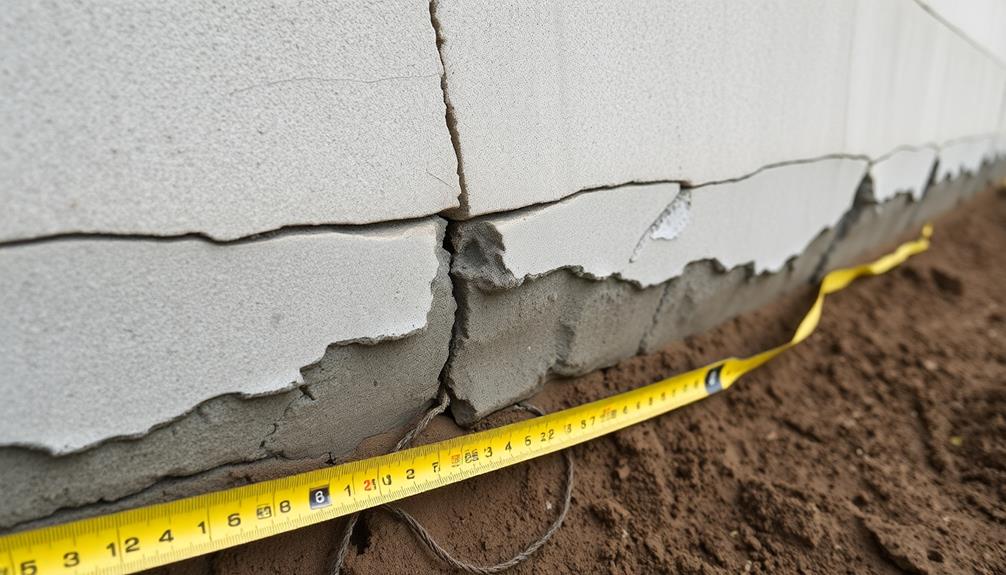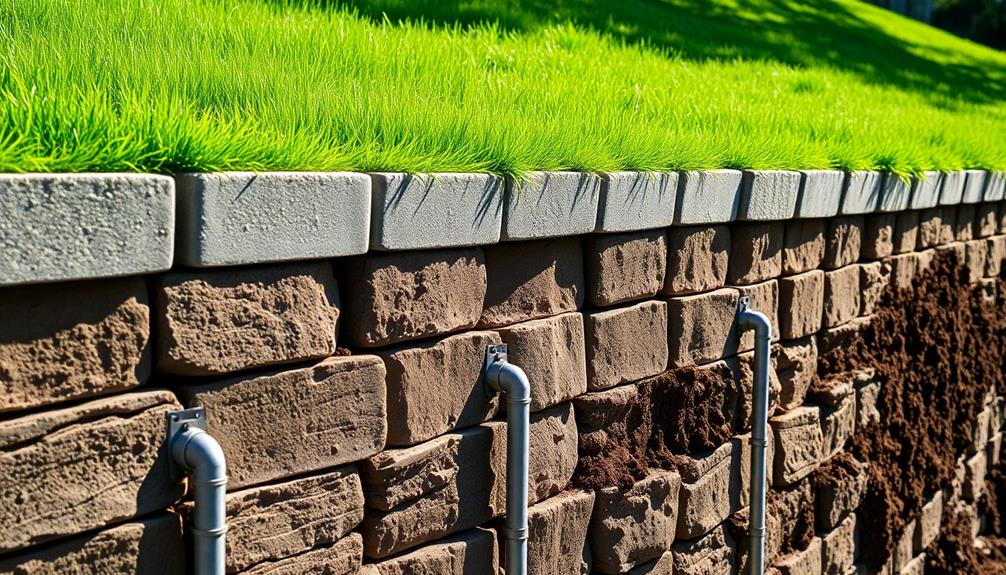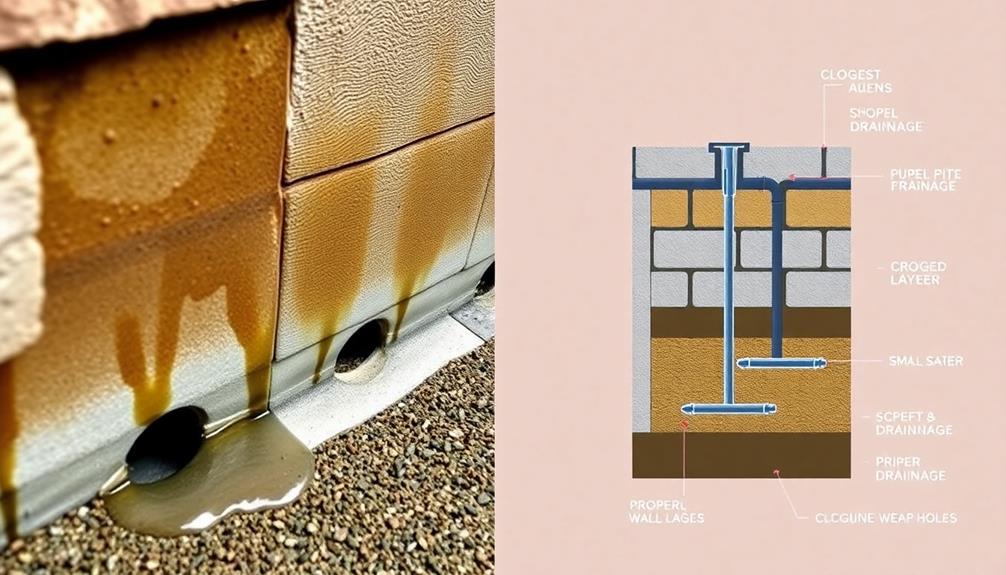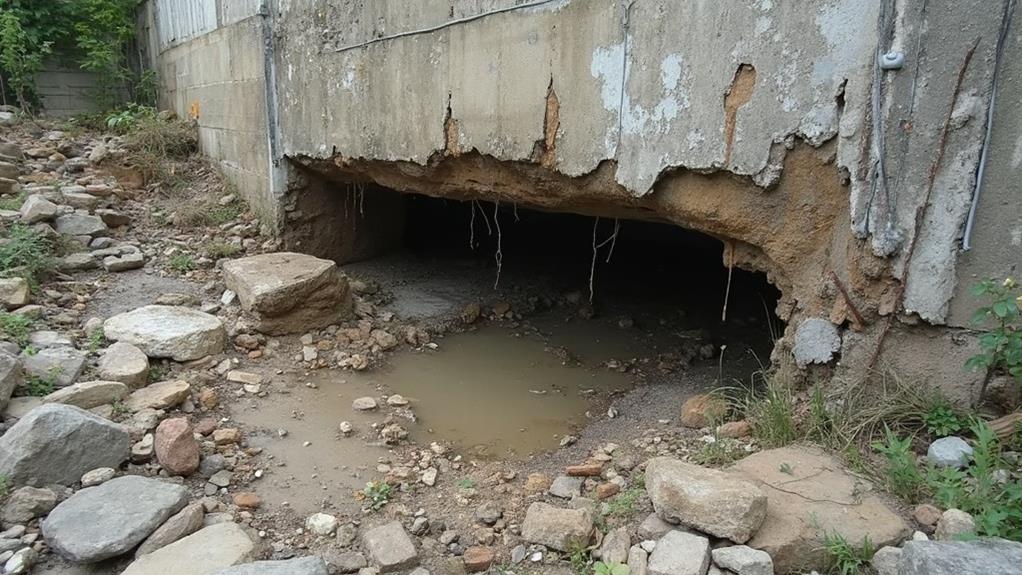Identifying common issues in retaining walls involves a thorough visual inspection and structural assessment. Key indicators include cracks, bulging, tilting, soil erosion, and water seepage, which may signify excessive pressure or settlement problems. Material deterioration signs, such as spalling concrete, corroded metal components, or rotting timber, should be carefully noted. Drainage system efficiency is paramount, requiring examination of outlets, weep holes, and surface drains. Professionals utilize specialized tools and techniques, including water flow testing and infrared thermography, to assess structural integrity and drainage performance. A systematic approach to inspection enables early detection of potential problems, ensuring the longevity and stability of retaining walls. Further exploration of these techniques can provide valuable insights for maintenance and prevention.
Table of Contents
ToggleWalls Contractor Highlights
- Look for cracks, bulges, or tilting in the wall structure, indicating potential instability or excessive pressure.
- Check for signs of water seepage, efflorescence, or dampness, which may suggest drainage problems.
- Examine the base of the wall for soil erosion, settling, or separation from the ground.
- Inspect for material deterioration like spalling concrete, rotting wood, or corroding metal components.
- Assess the drainage system's functionality by examining weep holes, surface drains, and water flow patterns.
Structural Integrity Assessment

Evaluating the structural integrity of retaining walls requires a thorough approach that incorporates various inspection techniques and analytical methods. Visual inspection techniques form the cornerstone of this assessment, allowing engineers to identify structural movement indicators and material deterioration signs that may compromise the wall's stability.
Depending on applications of boulder walls, it is equally important to examine how the wall handles factors like erosion and water redirection. These observations, when combined with advanced testing methods and engineering analysis, provide a comprehensive view of the retaining wall's condition and its ability to continue performing its intended function safely and effectively.
Visual Inspection Techniques
Visual inspection techniques form the cornerstone of structural integrity assessment for retaining walls. These methods allow professionals to identify potential issues before they escalate into critical problems. When conducting a visual inspection, experts systematically examine the wall's surface, looking for telltale signs of distress or deterioration. Key indicators include cracks, bulges, leaning, or displacement of the wall structure.
Inspectors also assess the condition of drainage systems, as proper water management is indispensable for maintaining wall stability. During the inspection process, professionals utilize specialized tools such as crack gauges, plumb bobs, and laser levels to measure and document any deviations from the wall's original design. They meticulously record their observations, often employing high-resolution photography to capture detailed images of problem areas. This documentation serves as a baseline for future comparisons and aids in developing targeted repair strategies.
Additionally, inspectors evaluate the surrounding landscape, noting any changes in soil conditions, vegetation growth, or nearby construction activities that may impact the wall's performance. By employing these thorough visual inspection techniques, structural engineers and maintenance teams can effectively identify and address potential issues, ensuring the longevity and safety of retaining wall structures.
Structural Movement Indicators
Several key indicators provide critical information about a retaining wall's structural integrity and potential movement. Observing these signs can help property owners and professionals identify issues before they escalate into essential problems.
One primary indicator is the presence of cracks, particularly those that are widening or extending over time. Horizontal cracks near the base of the wall often suggest excessive pressure, while vertical cracks may indicate differential settlement.
Another indispensable sign is wall tilting or bulging, which can be measured using a plumb bob or laser level to detect deviations from vertical alignment.
Soil erosion at the base or behind the wall is a significant concern, as it can undermine the wall's stability and lead to eventual failure. Water seepage through the wall or along its base may indicate drainage issues, potentially weakening the structure. Additionally, separation between the wall and adjacent structures or soil can signify movement.
Regular monitoring of these indicators, ideally through systematic measurements and photographic documentation, allows for early detection of structural changes. By understanding and recognizing these movement indicators, stakeholders can take proactive measures to address retaining wall issues and maintain the integrity of their property.
Material Deterioration Signs
The structural integrity of a retaining wall hinges on the condition of its materials. As fellow property owners and caretakers, we must remain vigilant in identifying signs of material deterioration to guarantee the longevity and safety of our retaining structures.
Common indicators include cracking, spalling, and erosion of concrete or masonry elements. These issues may manifest as visible fissures, flaking surfaces, or the exposure of reinforcing steel within concrete walls. For timber retaining walls, be alert to signs of rot, insect infestation, or warping of wooden components. Metal elements, such as tie-backs or anchors, may exhibit corrosion or rust, compromising their strength and effectiveness.
Additionally, efflorescence—a white, powdery substance on the surface of masonry or concrete—can indicate water infiltration and potential salt crystallization within the material. This process can lead to further degradation if left unaddressed. Discoloration, staining, or the presence of vegetation growing from within the wall structure may also signal moisture-related issues that require prompt attention.
Benefits

Retaining walls offer numerous advantages that extend beyond their primary function of soil retention. These structures can drastically increase property value by enhancing landscaping aesthetics and creating visually appealing outdoor spaces.
In addition, retaining walls, like versatile boulder walls, play an essential role in preventing soil erosion. They also expand usable space on sloped or uneven terrain, allowing property owners to maximize their land's potential.
Increased Property Value
With proper installation and maintenance, retaining walls can substantially boost a property's value. These structural enhancements not only serve functional purposes but also contribute in a significant manner to the overall aesthetics and usability of outdoor spaces. By effectively managing soil erosion and creating level areas on sloped terrain, retaining walls maximize the usable land on a property, thereby increasing its potential for landscaping, gardening, or outdoor living areas.
Moreover, well-designed retaining walls can enhance the visual appeal of a property, creating an attractive focal point that complements the existing architecture and landscape design. This improved curb appeal can be particularly advantageous when selling a home, as it creates a positive first impression for potential buyers. Additionally, retaining walls demonstrate a commitment to property maintenance and structural integrity, which can instill confidence in prospective purchasers.
From a practical standpoint, retaining walls can mitigate potential drainage issues and prevent soil erosion, which are crucial concerns for many homeowners. By addressing these problems proactively, property owners can avoid costly repairs and maintain the long-term value of their investment. Ultimately, the installation of a high-quality retaining wall represents a strategic improvement that can yield substantial returns in terms of property valuation and marketability.
Enhanced Landscaping Aesthetics
Three key benefits of retaining walls substantially improve landscaping aesthetics. First, these structures create visually appealing terraces and levels within a property, transforming flat or sloped areas into dynamic, multi-dimensional spaces. This layered approach allows for the strategic placement of plants, flowers, and decorative elements at varying heights, creating depth and interest in the landscape design.
Secondly, retaining walls provide an excellent opportunity to incorporate complementary materials and textures into the outdoor environment. Natural stone, brick, or concrete can be selected to harmonize with the architecture of the home and existing landscape features, enhancing the overall cohesiveness of the property's aesthetic.
Lastly, these structures offer practical solutions for defining and separating distinct areas within a landscape. By delineating spaces for gardens, patios, or walkways, retaining walls contribute to a sense of organization and purpose in the outdoor layout. This intentional design approach not only improves the visual appeal but also creates a more functional and enjoyable outdoor living space for property owners and their guests, fostering a sense of belonging and pride in one's surroundings.
Soil Erosion Prevention
Beyond their aesthetic value, retaining walls serve an essential functional purpose in preventing soil erosion. These structures act as a formidable barrier against the relentless forces of nature, safeguarding properties from the detrimental effects of soil displacement. By effectively managing water runoff and stabilizing slopes, retaining walls play a fundamental role in maintaining the integrity of landscapes and protecting valuable real estate investments.
The benefits of soil erosion prevention through retaining walls are multifaceted. Initially, they mitigate the risk of landslides and mudslides in areas with steep gradients, ensuring the safety of both structures and inhabitants. Secondly, these walls preserve topsoil, which is necessary for healthy plant growth and ecosystem sustainability. Additionally, by controlling water flow, retaining walls reduce sediment pollution in nearby water bodies, contributing to improved water quality and environmental health.
Moreover, the prevention of soil erosion helps maintain property boundaries and prevents encroachment issues between neighboring lots. Lastly, well-designed retaining walls can considerably extend the usable area of a property, allowing homeowners to maximize their outdoor living spaces while simultaneously protecting against erosion-related damages.
Expanded Usable Space
Retaining walls offer a notable advantage in expanding usable space on properties with challenging topography. By effectively managing slopes and elevations, these structures create level areas that would otherwise be inaccessible or impractical for use. Homeowners and property developers can transform steep hillsides into functional outdoor living spaces, gardens, or additional parking areas. This expansion of usable land not only enhances the property's aesthetic appeal but also increases its overall value.
In residential settings, retaining walls can create multi-tiered landscapes, allowing for the installation of patios, terraced gardens, or outdoor entertainment areas. Commercial properties benefit from increased parking capacity or expanded building footprints. Additionally, retaining walls can be designed to incorporate seating elements or planters, further maximizing the utility of the newly created space. The versatility of these structures enables property owners to optimize land use in ways that were previously impractical.
Drainage System Inspection Techniques

Proper drainage system inspection is indispensable for maintaining the integrity and longevity of retaining walls. Effective techniques include visual inspection for blockages, water flow testing methods, and monitoring drainage outlet performance. The following table outlines key aspects of these inspection techniques, providing an extensive approach to identifying potential issues before they escalate into major problems:
| Technique | Purpose | Frequency |
|---|---|---|
| Visual Inspection | Identify visible blockages or damage | Monthly |
| Water Flow Testing | Assess drainage system capacity | Bi-annually |
| Outlet Performance Monitoring | Evaluate efficiency of water discharge | Quarterly |
Visual Inspection for Blockages
A critical aspect of drainage system inspection for retaining walls is visual inspection for blockages. This process involves carefully examining the drainage components to identify any obstructions that may impede water flow. As homeowners and property managers, we must be vigilant in maintaining our retaining walls to guarantee their longevity and structural integrity.
To conduct a thorough visual inspection for blockages, follow these steps:
- Examine drainage outlets: Inspect visible drainage outlets at the base of the retaining wall for signs of debris accumulation or sediment buildup.
- Check weep holes: Carefully observe weep holes along the wall face for any obstructions, such as soil, vegetation, or foreign objects.
- Assess surface drains: Evaluate the condition of surface drains atop the wall, ensuring they are free from leaves, twigs, and other potential blockages.
- Inspect French drains: If accessible, examine French drain systems for signs of clogging or damage to perforated pipes.
Water Flow Testing Methods
Water flow testing methods serve as indispensable tools for evaluating the effectiveness of retaining wall drainage systems. These techniques allow property owners and maintenance professionals to identify potential issues before they escalate into more serious problems.
One common approach involves introducing a controlled amount of water into the drainage system and monitoring its flow rate and path. This can be accomplished by using specialized equipment such as flow meters or dye tracers, which provide quantitative data on water movement through the system.
Another effective method is the use of infrared thermography, which detects temperature variations caused by water infiltration or blockages. This non-invasive technique can reveal hidden issues within the retaining wall structure. Additionally, pressure testing can be employed to assess the integrity of drainage pipes and identify leaks or weak points. By applying controlled pressure to the system and measuring any pressure drops, technicians can pinpoint areas requiring attention.
These water flow testing methods, when used in conjunction with visual inspections, offer an exhaustive evaluation of retaining wall drainage systems, ensuring their longevity and ideal performance. Regular implementation of these techniques can prevent costly repairs and maintain the structural integrity of retaining walls.
Monitoring Drainage Outlet Performance
Building upon the foundation of water flow testing methods, monitoring drainage outlet performance is a key component of extensive retaining wall maintenance. This process involves regularly gauging the efficiency and functionality of drainage systems to prevent water accumulation and potential structural damage. By implementing a thorough monitoring program, property owners and maintenance professionals can identify and address issues before they escalate into costly repairs.
To effectively monitor drainage outlet performance, consider the following steps:
- Conduct visual inspections of outlet locations, checking for signs of blockages, erosion, or sediment buildup
- Measure water flow rates during and after precipitation events to guarantee proper discharge
- Utilize remote monitoring systems with sensors to track water levels and flow patterns
- Implement a maintenance schedule for cleaning and clearing drainage outlets
These proactive measures contribute to the longevity and stability of retaining walls, safeguarding against water-related complications. By adhering to a systematic approach, individuals responsible for retaining wall maintenance can guarantee optimal drainage performance, mitigating risks associated with water accumulation and soil saturation. This exhaustive strategy not only protects the structural integrity of the retaining wall but also preserves the aesthetic appeal and functionality of the surrounding landscape.
Walls Contractor FAQ
How Much Does It Cost to Repair a Retaining Wall?
The cost to repair a retaining wall varies widely, typically ranging from $800 to $15,000. Factors affecting price include wall size, material, extent of damage, and location. For an accurate estimate, consult local professionals in our community.
Can I Build a Retaining Wall Myself Without Professional Help?
While DIY retaining wall construction is possible for smaller projects, it's essential to ponder your skill level and local regulations. For safety and longevity, consulting a professional is suggested, especially for walls exceeding 4 feet in height.
What Materials Are Best for Constructing a Long-Lasting Retaining Wall?
For a durable retaining wall, consider using concrete blocks, natural stone, or pressure-treated timber. These materials offer excellent longevity and strength. Your choice should align with your project's aesthetic goals and local building codes, ensuring a lasting solution for our community.
How Often Should Retaining Walls Be Inspected for Potential Issues?
Regular inspections are vital for maintaining retaining walls. Experts recommend annual checks, with more frequent assessments after severe weather events. By staying proactive, we can guarantee the longevity and safety of our retaining walls, protecting our shared spaces.
Are There Eco-Friendly Options for Retaining Wall Construction and Maintenance?
Eco-friendly retaining wall options include using reclaimed materials, incorporating native plants, and choosing sustainable construction methods. These choices not only benefit the environment but also create a sense of harmony with nature in our outdoor spaces.







